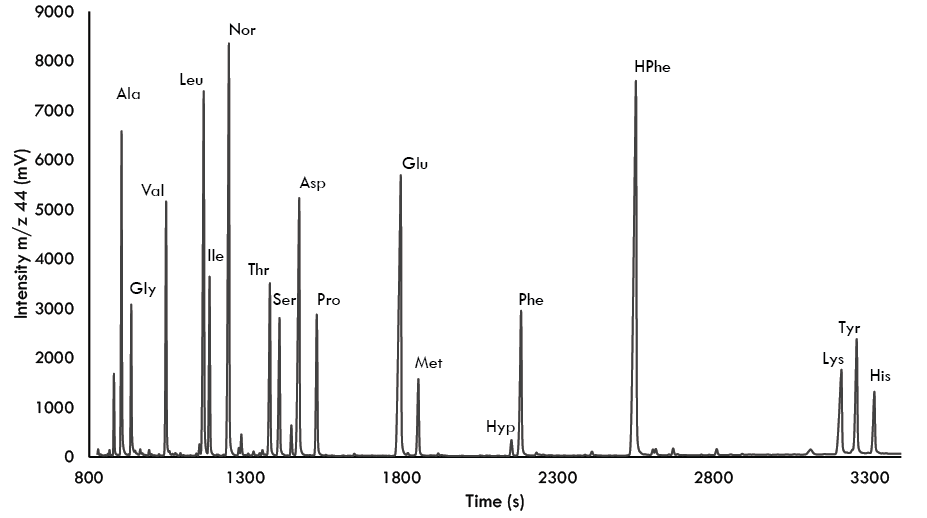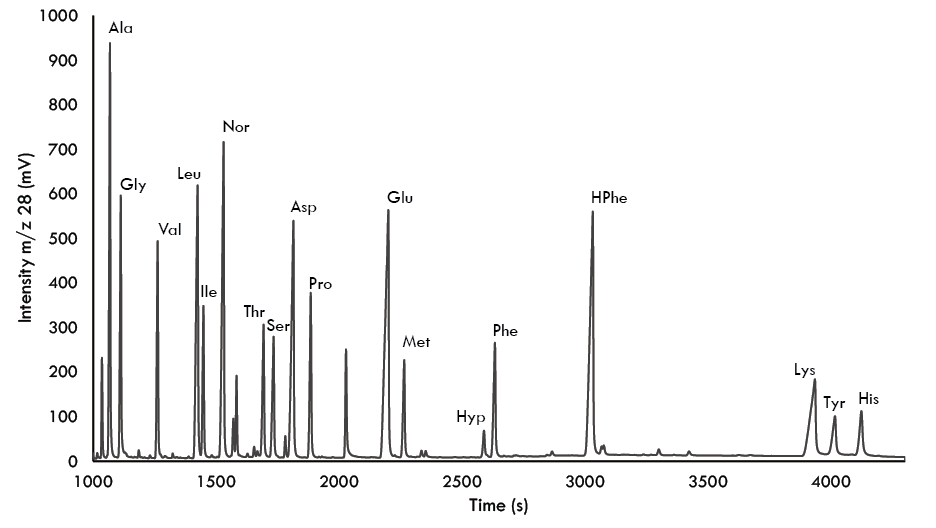13C & 13N Analysis of Amino Acids by GC-C-IRMS
GC-C-IRMS analysis of 13C and 15N in amino acids
Amino acids are made suitable for gas chromatography by derivatization as N-acetyl methyl esters (NACME, [1]). Prior to derivatization, amino acids are liberated from sample material proteins by acid hydrolysis (6 M HCl, 70 min, 150 ºC under N2 headspace). Additional purification steps, such as strong cation-exchange chromatography (SCX; Dowex 50WX8 resin), may be required for sample materials with significant fractions of carbohydrates, lipids, salts, or other potential matrix interferences.
NACME amino acid derivatives are injected at 260 ºC (splitless, 1 min) and separated on an Agilent DB 35 column (60 m X 0.32 mm ID, 1.5 µm film thickness) at constant flow rate of 2 mL/min under the following temperature program: 70 °C (hold 2 min); 140 °C (15 °C/min, hold 4 min); 240 °C (12 °C/min, hold 5 min); and 255 °C (8 °C/min, hold 35 min).
GC-C-IRMS is performed on a Thermo Trace GC 1310 gas chromatograph coupled to a Thermo Scientific Delta V Advantage isotope-ratio mass spectrometer via a GC IsoLink II combustion interface. The combustion reactor is a NiO tube containing CuO and NiO wires maintained at 1000 °C. Water is subsequently removed through a Nafion dryer before the analyte gases are transferred to the IRMS. During 15N analysis, CO2 is removed from the post-combustion carrier stream through the use of a liquid nitrogen trap to prevent isobaric interferences within the ion source.
All samples are analyzed in duplicate; further replicates may be analyzed if initial measurements fall outside expected measurement error. Replicates of the quality control and assessment materials are measured every 5 samples.

Fig. 1. Chromatogram of δ13C analysis of N-acetyl amino acid methyl ester derivatives from fish muscle.

Fig. 2. Chromatogram of δ15N analysis of N-acetyl amino acid methyl ester derivatives from fish muscle.
Calibration and Reporting of Stable Isotope Ratios
The pure amino acids used in quality control and assessment mixtures have been calibrated separately by EA-IRMS and are directly traceable to the primary isotopic reference material for each element (i.e., δ13C: V-PDB; δ15N: Air). EA-IRMS was performed using secondary reference materials calibrated against the following certified standard reference materials from the USGS and IAEA: IAEA-600, USGS-40, USGS-41, USGS-42, USGS-43, USGS-61, USGS-64, and USGS-65. Calibration procedures for CSIA of amino acids are applied identically across reference and sample materials. First, initial isotopic values for all amino acids are adjusted such that the known isotopic composition of an internal quality control reference material (Nor) is obtained. Next, the isotopic values of the individual amino acids are adjusted based on the first quality control reference mixture, UCD AA1, such that the known isotopic composition of each amino acid within the mixture is obtained. Finally, measurements are scale-normalized to the primary reference materials for δ15N (Air) using the second quality control reference mixture; in the case of δ13C analysis, calibration proceeds by accounting for the influence of exogenous carbon and potential kinetic isotope effects following derivatization [2,3]. Final quality assessment is based on the accuracy and precision of unbiased quality assessment materials, which include a calibrated amino acid mixture and multiple natural materials.
Measurement Uncertainty
Sample materials are inherently variable in amino acid composition. Some amino acids may not be measureable, and measurement error within amino acids varies between different sample types. Mean measurement error (σ) and accuracy, as determined by replicate measurements of the quality assessment material(s), must fall below expected measurement error (± 1 ‰) across amino acids. Accuracy and precision of the co-measured calibrated amino acid mixtures and quality assurance materials are provided with data reports. Limit of quantification, based on total peak area, is > 1 V-s for δ15N and > 10 V-s for δ13C.
References
1L.T. Corr, R. Berstan, P.O. Evershed. Optimisation of derivatisation procedures for the determination of δ13C values of amino acids by gas chromatography/combustion/isotope ratio mass spectrometry. Rapid Commun. Mass Spectrom. 2007, 21, 3759. [doi: 10.1002/rcm.3252]
2C.T. Yarnes and J. Herszage. 2017. The relative influence of derivatization and normalization procedures on the compound-specific stable isotope analysis of nitrogen in amino acids. Rapid Communications in Mass Spectrometry 31: 693-704. [doi: 10.1002/rcm.7832]
3G. Docherty, V. Jones, R.P. Evershed. 2001. Practical and theoretical considerations in the gas chromatography/combustion/isotope ratio mass spectrometry δ13C analysis of small polyfunctional compounds. Rapid Communications in Mass Spectrometry 15: 730-738. [doi: 10.1002/rcm.270]